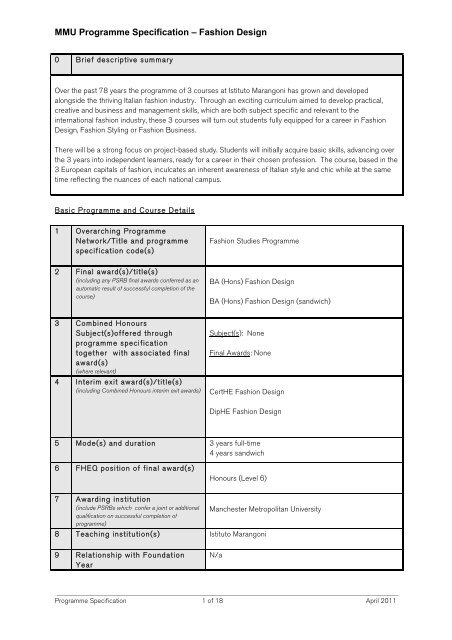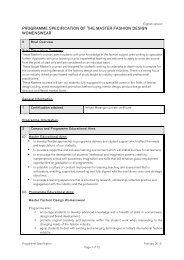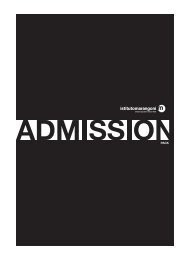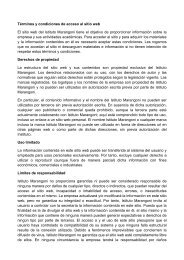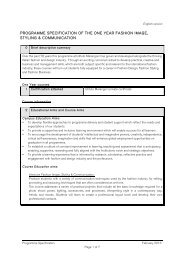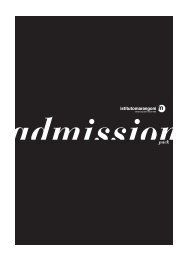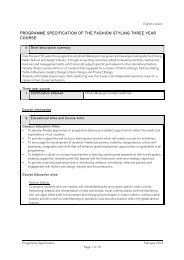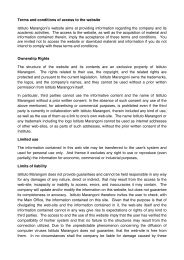london & paris programme specification BA ... - Istituto Marangoni
london & paris programme specification BA ... - Istituto Marangoni
london & paris programme specification BA ... - Istituto Marangoni
Create successful ePaper yourself
Turn your PDF publications into a flip-book with our unique Google optimized e-Paper software.
MMU Programme Specification – Fashion Design<br />
0 Brief descriptive summary<br />
Over the past 78 years the <strong>programme</strong> of 3 courses at <strong>Istituto</strong> <strong>Marangoni</strong> has grown and developed<br />
alongside the thriving Italian fashion industry. Through an exciting curriculum aimed to develop practical,<br />
creative and business and management skills, which are both subject specific and relevant to the<br />
international fashion industry, these 3 courses will turn out students fully equipped for a career in Fashion<br />
Design, Fashion Styling or Fashion Business.<br />
There will be a strong focus on project-based study. Students will initially acquire basic skills, advancing over<br />
the 3 years into independent learners, ready for a career in their chosen profession. The course, based in the<br />
3 European capitals of fashion, inculcates an inherent awareness of Italian style and chic while at the same<br />
time reflecting the nuances of each national campus.<br />
Basic Programme and Course Details<br />
1 Overarching Programme<br />
Network/Title and <strong>programme</strong><br />
<strong>specification</strong> code(s)<br />
Fashion Studies Programme<br />
2 Final award(s)/title(s)<br />
(including any PSRB final awards conferred as an<br />
automatic result of successful completion of the<br />
course)<br />
<strong>BA</strong> (Hons) Fashion Design<br />
<strong>BA</strong> (Hons) Fashion Design (sandwich)<br />
3 Combined Honours<br />
Subject(s)offered through<br />
<strong>programme</strong> <strong>specification</strong><br />
together with associated final<br />
award(s)<br />
(where relevant)<br />
4 Interim exit award(s)/title(s)<br />
(including Combined Honours interim exit awards)<br />
Subject(s): None<br />
Final Awards: None<br />
CertHE Fashion Design<br />
DipHE Fashion Design<br />
5 Mode(s) and duration 3 years full-time<br />
4 years sandwich<br />
6 FHEQ position of final award(s)<br />
Honours (Level 6)<br />
7 Awarding institution<br />
(include PSRBs which confer a joint or additional<br />
qualification on successful completion of<br />
<strong>programme</strong>)<br />
Manchester Metropolitan University<br />
8 Teaching institution(s) <strong>Istituto</strong> <strong>Marangoni</strong><br />
9 Relationship with Foundation<br />
Year<br />
N/a<br />
__________________________________________________________________________________________<br />
Programme Specification 1 of 18 April 2011
MMU Programme Specification – Fashion Design<br />
Administrative Details<br />
10 Home Department/ School/<br />
Institute<br />
Department of Clothing Design and Technology<br />
11 Home Faculty Hollings<br />
12 UCAS code(s) N/a<br />
Collaborative Arrangements<br />
13 Approved Collaborative<br />
partner(s)<br />
<strong>Istituto</strong> <strong>Marangoni</strong><br />
14 Description of type of<br />
collaborative provision or<br />
academic partnership<br />
Validated<br />
Approval Status<br />
15 Date and outcome of most<br />
recent MMU review/ approval<br />
N/a<br />
16 Next Scheduled Review Date: N/a<br />
17 PS/1 effective date:<br />
(ie date from which the outcome of approval or<br />
last review is effective OR the date from which<br />
amendments to the <strong>programme</strong> <strong>specification</strong> are<br />
effective)<br />
September 2011<br />
External References/Relationships<br />
18<br />
QAA Benchmark Statement(s)<br />
Art and Design<br />
19 PSRB(s) associated with final<br />
award of course<br />
(eg those which offer professional<br />
status/membership/license to practise as result of<br />
successful completion of the final award.<br />
20 Date and outcome of last PSRB<br />
approval(s)<br />
N/a<br />
N/a<br />
__________________________________________________________________________________________<br />
Programme Specification 2 of 18 April 2011
MMU Programme Specification – Fashion Design<br />
Course Information<br />
21 University and Course Educational Aims<br />
University Educational Aims:<br />
• To develop flexible approaches to <strong>programme</strong> delivery and student support which reflect the needs and<br />
expectations of our students.<br />
• To provide a supportive and inclusive learning environment which will enable success for all learners<br />
• To encourage the development of students’ intellectual and imaginative powers, creativity, independence,<br />
critical self-awareness, imagination and skills that will enhance global employment opportunities on<br />
graduation in all <strong>programme</strong>s.<br />
• To establish a culture of constant improvement in learning, teaching and assessment that is anticipatory,<br />
enabling, supportive, rewarding and fully aligned with the University’s vision and strategic objectives.<br />
• To provide a learning experience that is informed by research, scholarship, reflective practice and<br />
engagement with industry and the professions.<br />
Course Education aims:<br />
Fashion Design:<br />
To produce graduates who have a breadth of skills and knowledge in design, pattern and garment<br />
technology, responding to the changing needs of the industry. They will be equipped to deal with<br />
existing and emerging technologies in today’s apparel manufacturing and retailing environments, and<br />
have an understanding of business practices within the global clothing industry. We aim to send forth<br />
our graduates as independent life-long learners who can progress to industry, postgraduate study or a<br />
self-employed, creative life.<br />
__________________________________________________________________________________________<br />
Programme Specification 3 of 18 April 2011
MMU Programme Specification – Fashion Design<br />
22 Course Learning Outcomes<br />
MMU Educational Outcomes:<br />
On successful completion of their course of study MMU graduates will be able to:<br />
• apply skills of critical analysis to real world situations within a defined range of contexts;<br />
• demonstrate a high degree of professionalism characterised by initiative, creativity, motivation and<br />
self management;<br />
• express ideas effectively and communicate information appropriately and accurately using a range<br />
of media including ICT;<br />
• develop working relationships using teamwork and leadership skills, recognising and respecting<br />
different perspectives;<br />
• manage their professional development reflecting on progress and taking appropriate action;<br />
• find, evaluate, synthesise and use information from a variety of sources;<br />
• articulate an awareness of the social and community contexts within their disciplinary field;<br />
1. Honours Degree Learning Outcomes<br />
On successful completion of the <strong>BA</strong> (Hons) Fashion Design course, students will be able to:<br />
• Understand the fashion design process and, within that framework, have developed the creative,<br />
intellectual and technical skills necessary to practice within the fashion industry;<br />
• Apply both current and emerging relevant technology, with the intention of demonstrating their<br />
understanding of the role and application of these technologies;<br />
• Demonstrate their ability to collate and communicate ideas and information within a variety of roles<br />
in the fashion industry.<br />
• Engender a professional approach by demonstrating their skills to solve problems, evaluate<br />
evidence, conclude and present arguments appropriate for graduate employment or education at<br />
Postgraduate level.<br />
In addition, students who have engaged in the placement within the Fashion industry and have successfully<br />
passed the placement year will be able to:<br />
• Apply theoretical understanding into a practical application within a working environment.<br />
2. Pass Degree Learning Outcomes<br />
Students who are awarded a Pass Degree in Fashion Design will be able to:<br />
• Understand the fashion design process and, within that framework, begin to develop the creative,<br />
intellectual and technical skills necessary to practice within the fashion industry;<br />
• Appreciate both current and emerging relevant technology, with the intention of demonstrating their<br />
basic understanding of the role and application of these technologies;<br />
• Demonstrate a fundamental ability to collate and communicate ideas and information within a variety<br />
of roles in the fashion industry.<br />
__________________________________________________________________________________________<br />
Programme Specification 4 of 18 April 2011
MMU Programme Specification – Fashion Design<br />
• Express their ability to solve problems, evaluate evidence, conclude and present arguments.<br />
23 Interim Award Learning Outcomes<br />
Certificate Higher Education<br />
Students successfully completing Level 4 may proceed to Level 5, or they may complete their studies at this<br />
stage and thereby qualify for a Certificate of Higher Education in Fashion Design.<br />
Students successfully completing Level 4 will have developed:<br />
• A basic understanding of the elements involved in the design process used in the fashion industry;<br />
• A fundamental knowledge of the supporting business and fashion garment construction and<br />
development process;<br />
• The ability to take different approaches to problem solving;<br />
• The ability to communicate accurately;<br />
Diploma of Higher Education<br />
Students successfully completing Level 4 and 5 may proceed to Level 6, or they may complete their studies<br />
at this stage and thereby qualify for a Diploma of Higher Education in Fashion Design.<br />
Students successfully completing Level 5 will have developed:<br />
• A sound understanding of the principles involved in the design process used in the fashion industry<br />
and how to apply these principals to fashion product development;<br />
• A detailed understanding of the new fabrics and technologies that support the changes within the<br />
fashion industry;<br />
• The ability to evaluate the appropriateness of different approaches to problem solving.<br />
24 Teaching/Learning and Assessment Strategy<br />
Curriculum Design<br />
The <strong>programme</strong> is offered as three specialist courses in the fashion subject either as a 3-year full-time course<br />
or 4-year sandwich course, with placement taking place between Levels 5 and 6.<br />
The curriculum design allows for students who do not progress from Level 4 to 5, but who have 120 Credits<br />
at Level 4, to qualify for a Certificate of Higher Education. Likewise students who do not progress to Level 6<br />
from 5, but who have 120 Credits at both Level 4 and 5, qualify for a Diploma of Higher Education.<br />
The Programme is designed to facilitate the development of a student who will be highly employable and will<br />
allow them to investigate and develop their strengths in one of the 3 chosen specialist courses. The<br />
<strong>programme</strong> will present students with a variety of approaches to learning and assessment strategies that will<br />
promote students’ intellectual, imaginative, analytical and critical judgement. It will allow students to develop<br />
understanding as well as their presentation and communication skills, which they will be able to demonstrate<br />
in a variety of forms.<br />
__________________________________________________________________________________________<br />
Programme Specification 5 of 18 April 2011
MMU Programme Specification – Fashion Design<br />
A combination of different learning and teaching methodologies are employed in order to promote reflective<br />
learning and develop generic transferable skills.<br />
Methods include:<br />
• projects to encourage independent learning through investigation, enquiry and problem solving;<br />
• group project to enhance interpersonal and collaborative skills;<br />
• tutorials and group tutorials to facilitate shared experiences and best practice;<br />
• Seminars, formal lectures and workshops<br />
• Scholastic trips, external projects and competitions present the students with another dimension to<br />
their leaning experience.<br />
• Guest speakers provide the students with a full, broader and real prospective to their specialist field<br />
of study.<br />
Students will have the opportunity to demonstrate their achievement of the intended learning outcomes<br />
through a variety of means appropriate to their field of study:<br />
The <strong>BA</strong> (Hons) Fashion Design course is part of the three-year full time <strong>programme</strong>, with an option to<br />
undertake a four-year sandwich <strong>programme</strong>. This <strong>programme</strong> is delivered through a variety of learning and<br />
teaching methods, which include seminars, tutorials, workshop inductions, study visits, lectures, IT workshops,<br />
library sessions, group projects, and independent research.<br />
At Level 4 the unit framework will provide an opportunity for students from widely varied backgrounds and<br />
abilities to learn the fundamentals of drawing ensuring that by the end of the year they will become proficient<br />
in expressing their ideas in 2D with good presentation skills.<br />
Pattern cutting and construction classes throughout the first year will give students an introduction to the<br />
technical skills required and how they relate to, and are supported by academic practice and contemporary<br />
fashion design issues. Students will compile a technical file, which includes construction, details and<br />
manipulations. Portfolio and Collection Creation Unit will help students aim towards the production of an<br />
individual portfolio and sketchbooks with photographic reference; sketches, ideas, collages, fabric samples<br />
and a range plan for different markets. A great deal of the focus is placed on working towards practical output<br />
through projects set by tutors.<br />
The units comprising Level 5 are designed to encourage students to experiment widely and challenge their<br />
existing ideas and approach to design implementing skills learnt from Level 4. To this end, units will<br />
encourage the students to experiment and develop their own personal style. Students will target their<br />
collections to a variety of market segments. The creative work will take place in the design and pattern<br />
making studio, a realistic working environment in which students experiment with fabrics, print, pleating,<br />
silhouettes and details. Students will work with fabric suppliers, print/knit technicians and sample machinists<br />
towards the production of their capsule collection, developing their practical skills with the support of tutors.<br />
Level 5 units will prepare students to express, evaluate and present ideas and information clearly in a variety<br />
of forms appropriate to the situation and audience. At this level, students will be introduced to the practice of<br />
keeping Reflective Learning Journals.<br />
Students on the sandwich <strong>programme</strong> who successfully complete level 5 have the option to progress to the<br />
Placement Year. This is normally for a minimum period of 36 weeks and on satisfactory completion the<br />
student is awarded 120 Practice Credits. The Placement Panel, however, reserves the right to recommend to<br />
the appropriate Examination Board that a student should progress directly onto the Level 6 of the <strong>programme</strong><br />
and thus graduate with a full-time award.<br />
Whereas Level 5 encourages diverse experimentation and a challenging approach to thinking, at Level 6<br />
students’ skills are honed to increasingly produce well-informed finished pieces of work that communicate<br />
their ideas. By this stage the students are aiming to work as independent practitioners.<br />
Fashion Marketing within units will help students to research and analyse different markets, understand<br />
consumer demographics, competitors, price points, marketing methods, promotion and the preparation of a<br />
business plan. At this level of study the student will be equipped to work as a self-employed entrepreneur.<br />
The introduction to Reflective Learning Journals at Level 5 will endow them with the self-analysis necessary<br />
__________________________________________________________________________________________<br />
Programme Specification 6 of 18 April 2011
MMU Programme Specification – Fashion Design<br />
to become independent thinkers at Level 6. A portfolio of developmental work will support the final major<br />
project, the Collection Design Unit. It will demonstrate the culmination of the students’ studies and enable<br />
them to develop work capable of confronting clients, employers, sponsors and curators.<br />
At the end of Level 6, students have a choice of units, which they can discuss with their Key Tutor and<br />
Programme Leader. Collection Development allows students to develop their collection further in relation to<br />
industry whilst Industry Portfolio Preparation prepares students for interview with a specific company or<br />
market level. Both these Units play to the students’ strengths.<br />
The Theory Units run through all 3 years of the <strong>BA</strong> (Hons) Fashion Design courses forming<br />
a firm basis for studio practice.<br />
The Level 4 Theory unit, History of Art and Dress, is designed to paint a broad picture of the evolution of Art<br />
and Dress from early evidences, e.g. Mesopotamia, Ancient Egypt to the end of the 19th Century. The<br />
element of Dress will be taught in terms of cut and construction, the development of fabrics & materials,<br />
jewellery design, footwear, and hair & makeup. Students will explore the relationship between artistic<br />
movements and the development of dress, within a wider social, cultural, historical and political framework.<br />
They will draw parallels between artistic movements and the way they are interpreted in recent fashion<br />
collections.<br />
Students will become competent both in the demands of academic study and in the skills of effective<br />
communication in written format. They will access electronic archives and databases and a range of library<br />
resources, relevant to their discipline.<br />
At Level 5, Fashion and Cultural Contemporary Perspectives, starts with a presentation of contemporary<br />
developments in Fashion Studies from 1900 to the present day. In the second and third terms students<br />
select one option from those on offer:<br />
1. Fashion and Consumerism<br />
2. Fashion Photography and Desire<br />
3. Gender Identity and the Body<br />
4. Future-Fashion<br />
At Level 6, Researching Theory and Practice, will give students the opportunity to critically research, and<br />
through their investigations, gain expert knowledge of a specialist area within their studio practice. It will be<br />
expected that their choice of subject will be able to sustain sufficient breadth and depth of enquiry, to review<br />
elements of the social, economic, cultural, and historical implications of their area of study.<br />
As the research stage progresses students will be asked to submit an initial 500-word written Synopsis. This<br />
will be followed by a 5,000-word dissertation, which brings together their theoretical and practical work.<br />
Course Specific Assessment Criteria<br />
MMU Regulations for Undergraduate Programme of Study apply to all stages of assessment.<br />
The methods of assessment used give breadth and depth, which allow for both the formative and summative<br />
assessment of every student at each stage of the <strong>programme</strong>.<br />
Assessment methods to support learning:<br />
The Fashion Studies Programme uses a balanced assessment system, both summative and formative as an<br />
integral part of gathering information on student learning. Different forms of assessment can, and where<br />
appropriate should, be used to test different types of skills and learning.<br />
Formative Assessment:<br />
Formative assessment informs both teachers and students about student understanding at a point when<br />
timely adjustments can be made. In formative assessment students will be involved in the assessment<br />
__________________________________________________________________________________________<br />
Programme Specification 7 of 18 April 2011
MMU Programme Specification – Fashion Design<br />
process. These formative assessment situations will also give students an opportunity to learn to critique the<br />
work of others. Some of the instructional strategies that will be used formatively include the following:<br />
• Criteria and goal setting: asking students to participate in establishing what should be included in<br />
criteria for success.<br />
• Self and peer assessment: With peer evaluation, students see each other as resources for<br />
understanding and checking for quality work against previously established criteria.<br />
• Student record keeping: helps students better understand their own learning as evidenced by their<br />
classroom work. This process of students keeping ongoing records of their work not only engages students, it<br />
also helps them, beyond a "grade," to see where they started and the progress they are making toward the<br />
learning goal.<br />
Summative Assessments:<br />
These assessments are a means of gauging student learning, at a particular point in time, relative to<br />
established marking criteria. Summative assessments can occur during as well as at the end of each unit and<br />
concentrate on specific evidence of student work, examples as follows:<br />
Portfolio Assessment is used to assess a variety of projects that have been developed throughout the<br />
unit.<br />
Practical Coursework allows the students to demonstrate their understanding and application of practical<br />
areas of study.<br />
Written Reports are required is some study areas, where a clear and structured brief is provided and the<br />
students are asked to submit work to me marked independently and anonymously by staff.<br />
Formal Examinations are required is some study areas.<br />
Presentations are used in some subjects to allow the student to develop their professional communication<br />
and presentation skills.<br />
Student Projects are used when the student is required to submit work to be marked independently and<br />
anonymously.<br />
25 Course structures, levels, credits, awards, curriculum map of all units (identifying<br />
core/option status, credits pre or co-requisites) potential entry/exit points and<br />
progression/award requirements<br />
Fashion Design Honours Degree: Full-time<br />
Level 4<br />
Core Units<br />
Code Status Unit Title No of<br />
credits<br />
Core Architecture of Design 30<br />
Core Fabric Exploration & Design 30<br />
Core Portfolio & Collection Creation 30<br />
Core History of Art and Dress 30<br />
On successful completion of Level 4 – interim exit award: CertHE Fashion Design<br />
__________________________________________________________________________________________<br />
Programme Specification 8 of 18 April 2011
MMU Programme Specification – Fashion Design<br />
Level 5<br />
Core Units<br />
Code Status Unit Title No of<br />
credits<br />
Core Brand Revival 30<br />
Core Art & Fashion Interface 30<br />
Core Personal Style 30<br />
Core Fashion, Culture and Contemporary Perspectives 30<br />
On successful completion of Levels 4 & 5 – interim exit award: DipHE Fashion Design<br />
Level 6<br />
Core Units<br />
Code Status Unit Title No of<br />
credits<br />
Core Pre-Collection 30<br />
Core Collection Design 30<br />
Core Researching Theory and Practice 30<br />
Option Units<br />
Choose 1 from options listed<br />
Core Collection Development 30<br />
Option<br />
Core<br />
Option<br />
Industry Portfolio Preparation 30<br />
On successful completion of Level 6 – Final exit award: <strong>BA</strong> (Hons) Fashion Design<br />
Fashion Design Honours Degree: Sandwich<br />
Level 4<br />
Core Units<br />
Code Status Unit Title No of<br />
credits<br />
Core Architecture of Design 30<br />
Core Fabric Exploration & Design 30<br />
Core Portfolio & Collection Creation 30<br />
Core History of Art and Dress 30<br />
On successful completion of Level 4 – interim exit award: CertHE Fashion Design<br />
Level 5<br />
Core Units<br />
Code Status Unit Title No of<br />
credits<br />
Core Brand Revival 30<br />
__________________________________________________________________________________________<br />
Programme Specification 9 of 18 April 2011
MMU Programme Specification – Fashion Design<br />
Core Art & Fashion Interface 30<br />
Core Personal Style 30<br />
Core Fashion, Culture and Contemporary Perspectives 30<br />
On successful completion of Levels 4 & 5 – interim exit award: DipHE Fashion Design<br />
Placement Year<br />
Core Units<br />
Code Status Unit Title No of<br />
credits<br />
Core Placement 120<br />
Level 6<br />
Core Units<br />
Code Status Unit Title No of<br />
credits<br />
Core Pre-Collection 30<br />
Core Collection Design 30<br />
Core Researching Theory and Practice 30<br />
Option Units<br />
Choose 1 from options listed<br />
Core Collection Development 30<br />
Option<br />
Core<br />
Option<br />
Industry Portfolio Preparation 30<br />
On successful completion of Level 6 – Final exit award: <strong>BA</strong> (Hons) Fashion Design (sandwich)<br />
26 Personal Development Planning<br />
The most widely accepted definition of PDP is that of the Quality Assurance Agency, which defines PDP as<br />
“a structured and supported processes to develop the capacity of individuals to reflect on their own learning<br />
and achievement, and to plan for their own personal and educational and career development.” (QAA 2001).<br />
PDP offers a structured way to reflect on what the student is good at and what needs to develop further.<br />
It encourages students to rate their current skill levels attained at the institute and learned from different<br />
situations and environments including external studies, part time work, voluntary work and other social<br />
activities.<br />
This <strong>programme</strong> conforms to MMU’s Faculty of Art and Design’s PDP Framework, whereby PDP is viewed as<br />
a process that is embedded within the curriculum.<br />
It is an ongoing process of students reflecting on their development as learners and on their aspirations for<br />
their future learning and professional practice.<br />
PDP/Individual Development Tutorial.<br />
All students on all three courses are required to participate in PDP.<br />
Students prepare themselves for this tutorial through a reflective survey of their learning journal that is<br />
supported and guided by a set of questions from their Key Tutor. Initially they will be asked to reflect on their<br />
__________________________________________________________________________________________<br />
Programme Specification 10 of 18 April 2011
MMU Programme Specification – Fashion Design<br />
existing skills and determine where their strengths lie. Then they will be assisted in determining their<br />
development needs and setting some development goals.<br />
Success in achieving these goals will be determined in a variety of ways: through their studies; extracurricular<br />
activities etc and, with the support of the Key Tutor, the student will be able to recognize and record<br />
these successes, setting further goals as required.<br />
There are two PDP tutorials for each student per academic year given by the Key Tutor during the three<br />
years of these courses. In the case of the Sandwich courses the placement tutor will give added support in<br />
the career development discussions during this year.<br />
At the end of the course all students are given the opportunity to meet with the campus placement officer<br />
and discuss their future employment goals.<br />
27 Placement and Work-based Learning<br />
All students enrolled on the sandwich <strong>programme</strong> will undertake the Placement unit between Levels 5 and 6.<br />
This is normally for a minimum period of 36 weeks. The placement experience is designed to help prepare<br />
students for employment and they will be capable of following careers in a wide variety of sectors of the<br />
industry.<br />
Each campus has it’s own dedicated Careers Services Manager that heads the careers support team.<br />
The purpose of the support officer is to bridge the gap between the fashion industry located in the city/<br />
country of campus and the student/graduate. The Career services Manager builds and expands on industry<br />
relationships in their city, creating a variety of learning opportunities for the students, such as live briefs,<br />
competitions, visits and industry lectures.<br />
Students on the three-year full-time <strong>programme</strong> look for placement opportunities after graduation.<br />
All students are supported by lectures, PowerPoint presentations and notes, on internship, the nature of the<br />
fashion industry, preparation of CVs, cover letter writing, developing and preparing a portfolio inline with a job<br />
interview and how to adopted interview skills.<br />
As “placement” includes any activity which a student engages with off-site, it should be also notes that during<br />
the course of the <strong>programme</strong> students will be given the opportunity to join study trips and submit work<br />
towards industry sponsored competitions.<br />
Study trips may take many forms, such as: short excursions to museums, galleries or retail environments;<br />
structured visits to view industrial sites, marketing/buying offices, showrooms, fashion and textiles/yarn trend<br />
exhibitions and fairs.<br />
28 Course Specific Admission Requirements<br />
Admission to the <strong>programme</strong> is in accordance with Manchester Metropolitan University entry requirements.<br />
Entry into Level 4<br />
The normal minimum age for entry shall be 18 years.<br />
The normal entry requirements are:<br />
International Baccalaureate.<br />
or<br />
- UK, subjects and grads required are:<br />
__________________________________________________________________________________________<br />
Programme Specification 11 of 18 April 2011
MMU Programme Specification – Fashion Design<br />
or<br />
or<br />
or<br />
or<br />
or<br />
• GCSE Grade C (or above) in three subjects normally including English and Maths AND passes<br />
in either two subjects at GCE Advanced Level (A2) or Vocational Advanced Level (six unit), or<br />
one subject at Vocational Advanced Level (Double Award)<br />
• BTEC Higher National Diploma or Certificate<br />
• BTEC National Diploma<br />
• The traditional Advanced GNVQ at merit level<br />
• Scottish Certificate of Education with passes in the three subjects at Higher Grade (C or above)<br />
and two subjects at Standard Grade (3or above)<br />
• Irish Leaving Certificate with passes in five at grade C or above, four of which should be at<br />
Higher/Honours Level<br />
The Admissions Tutor may accept other qualifications as are deemed to be acceptable in lieu of the specified<br />
above.<br />
Undergraduate courses:<br />
Pearson Test of English (PTE<br />
Academic)<br />
PTE 53<br />
IELTS 6.0, with no element below 5.5<br />
TOEFL Paper based 570, with TWE of 4-4.5<br />
TOEFL iBT 79<br />
Cambridge Advanced<br />
Cambridge Proficiency<br />
B2<br />
C1<br />
Entry to Other Levels<br />
Direct entry into Level 5 is only be considered if the following requisites are demonstrated by the applicant<br />
with evidence of:<br />
• Appropriate level of study & skills demonstrated in a body of work comparable to the learning<br />
outcomes of Level 4 i.e. portfolio (when appropriate to the subject of study)<br />
• Credits successfully undertaken relating to study at comparable <strong>programme</strong> at a similar institution at<br />
Level 4<br />
• Work experience that relates to skills needed at this level.<br />
In the UK they could typically have already have achieved the following:<br />
• Foundation Degree in a relevant subject<br />
or<br />
• Equivalent qualification in a relevant subject at another institution<br />
or<br />
• Can demonstrate equitable skills and commitment to study<br />
Students wanting to study the sandwich course may apply for entry into the Placement Year with a<br />
relevant Foundation degree or equivalent, but must be able to demonstrate that previous study has allowed<br />
them to achieve the learning outcomes of either:<br />
• Level 5 of a <strong>BA</strong> (Hons) Fashion Design<br />
In the appropriate subject area.<br />
__________________________________________________________________________________________<br />
Programme Specification 12 of 18 April 2011
MMU Programme Specification – Fashion Design<br />
Applicants will normally be expected to have achieved 50% in Level 5 of their Foundation Degree to be<br />
accepted for the Honours Degree and demonstrate at interview their commitment to further study.<br />
Students may also apply for entry at Level 6 with a relevant Foundation degree, or equivalent, but must be<br />
able to demonstrate that previous study has allowed them to achieve the Learning Outcomes of:<br />
• Level 5 of a <strong>BA</strong> (Hons) Fashion Design<br />
In the appropriate subject area.<br />
It is also essential that international students have sufficient command of English to meet the higher<br />
requirements of the <strong>programme</strong> in every respect at this Level.<br />
Entry into Level 6 a student must have a minimum IELTS 6.5 (or similar TOEFL or Cambridge award).<br />
International Applicants<br />
International applicants, for Level 4, must have sufficient command of English to meet the requirements of<br />
the <strong>programme</strong> in every respect. If they have previously studied in the UK students are normally expected to<br />
have attained either a grade c or above in GCSE English Language or the equivalent. Other international<br />
applicants, for whom English is not their first language, IELTS at grade 6.0 (with no element below 5.5)<br />
TOEFL 213 + points on the computer-based test are a requirement for the admission to the <strong>programme</strong>.<br />
As above, incremental learning throughout the course would make it necessary for Level 6 applicants to have<br />
an IELTS score of no less than grade 6.5 (or similar TOEFL or Cambridge award)<br />
Admission Exemptions<br />
Exceptionally, the Admissions Officer may accept an applicant whose qualifications do not conform to the<br />
standard requirements.<br />
Admission with Specific Credit<br />
In order to be admitted to the <strong>programme</strong> with specific credit or advanced standing, the applicant shall satisfy<br />
the Admissions Tutor that they have fulfilled some of the progression and assessment requirements of the<br />
<strong>programme</strong> by means other than attendance on the <strong>programme</strong> and that they will be able, by completing the<br />
remaining requirements, to fulfil the objectives of the <strong>programme</strong> and attain the standard required for the<br />
award.<br />
Admission with Specific Credit shall, in all cases, mean that an applicant’s prior qualification and/or learning<br />
are accepted as fulfilling some of the requirements of the <strong>programme</strong>.<br />
Accreditation of Prior (Experiential) Learning (AP(E)L)<br />
The Admissions Officer in compliance with Manchester Metropolitan University’s Accreditation of Prior<br />
Experiential Scheme will consider applicants for admission with prior learning or prior experiential learning on<br />
an individually basis.<br />
29 Approved Variations/Exemptions from University Regulations<br />
N/a<br />
30 Programme Leader Responsibilities<br />
They will have the responsibility for implementing the strategic direction of the courses within their<br />
__________________________________________________________________________________________<br />
Programme Specification 13 of 18 April 2011
MMU Programme Specification – Fashion Design<br />
<strong>programme</strong> and for co-ordinating the academic administration necessary for its successful day-to-day<br />
operation.<br />
Responsibilities<br />
1. Programme Leader’s job profile will combine the roles of the Unit Tutor. His/her responsibilities will,<br />
therefore, include:<br />
2. Chairing the Programme Committee, and arranging for such meetings of the Committee as<br />
considered appropriate.<br />
3. Link Tutor with MMU, representing their course and campus<br />
4. Acting as the Chief Executive Officer to the <strong>programme</strong>. As such he/she will be responsible, within<br />
the agreed policies of the Programme Committee, and Academic Boards, for the efficient operation<br />
of the <strong>programme</strong> as approved by the Institute.<br />
5. All matters pertinent to the proper day-to-day operation of the <strong>programme</strong> involving leading,<br />
supporting and encouraging their teaching team including PDP.<br />
6. Advise the Programme Committee on its proper responsibility for the continuing development of the<br />
<strong>programme</strong>.<br />
7. Liaise on behalf of the Programme Committee with all staff as appropriate.<br />
8. Be empowered to take on behalf of the Programme Committee any reasonable action with respect<br />
to the proper functioning of the <strong>programme</strong>.<br />
9. Assess the value of the unit in terms of staff delivery and integration with the rest of the <strong>programme</strong>.<br />
10. Recommend areas for curriculum development.<br />
11. Co-ordinate the assessment schedule for the Unit and ensure that it is communicated to students<br />
and the director of education.<br />
12. Liaise with Student Support Officers to ensure that appropriate study support is available<br />
13. Recommend the appropriate level of resource required for the Unit & liaise with the teaching team.<br />
14. Undertake in training and professional development and contribute to the training of others.<br />
15. Actively participate and organise Peer Support system<br />
16. Monitoring & responding to the student voice including regular meetings with the student Rep.<br />
17. Monitor Unit and course feedback, student voice and External Examiners report responding in<br />
Annual Monitoring & Evaluation Report (AME) and the Quality Action Plan (QAP)<br />
18. Organise all areas of assessment procedures, facilitate monitoring, joint marking, internal verification<br />
(IV) and External Examiner visits.<br />
19. Maintaining the quality of academic standards by supporting the rules and regulations concerning<br />
exam procedures and conduct of the student and teaching team.<br />
Joint Responsibilities:<br />
Admissions: Management of admissions is undertaken by the administrative admissions manager whom<br />
coordinates and supports the subject specific Programme leader and the Campus Director of Education in<br />
dealing with interviews and portfolio assessments (where appropriate).<br />
Placement: Placement managers on each campus liaise with industry and support the Placement Tutor<br />
(appointed form the teaching staff) in academic monitoring during the placement year.<br />
31 Other Staff Responsibilities<br />
Key staff are appointed to give PDP guidance to their students. These are identified as the teaching team<br />
that has most contact time and subject specific knowledge to support their student group. They report to the<br />
<strong>programme</strong> leaders directly.<br />
A team of Professional Practitioners undertakes all other teaching roles. This has always been the <strong>Istituto</strong><br />
<strong>Marangoni</strong> method and teaching policy. It is recognised that they bring currency, knowhow and industry<br />
contacts into the institute.<br />
The teaching teams report to the direction of the <strong>programme</strong> leaders.<br />
As they are all specialists in their areas of teaching they are expected to liaise with the PLs for the following:<br />
__________________________________________________________________________________________<br />
Programme Specification 14 of 18 April 2011
MMU Programme Specification – Fashion Design<br />
• Subject & curriculum developments<br />
• Seminar and lecture proposals<br />
• Placement Tutor<br />
• Updating of information concerning space resources that might be required<br />
• Book lists for the developments of the campus learning resources<br />
• Meeting with Programme Leaders in both one-to-one and plenary meetings twice a year.<br />
• Play the key role in grading and giving valuable feedback during exam session<br />
• Maintaining the quality of academic standards by supporting the rules and regulations concerning<br />
exam procedures and conduct of the student body.<br />
• Participate in Peer Support of Teaching Staff exercise.<br />
Joint Responsibilities:<br />
Placement: Placement managers on each campus liaise with industry and support the subject specific<br />
Placement Tutor in the support and academic monitoring during the placement year.<br />
32 Student Support Strategy<br />
<strong>Istituto</strong> <strong>Marangoni</strong>’s Departmental Policies ensure that various mechanisms are in place to enhance the<br />
student experience, in an academic, practical and pastoral way:<br />
a. Programme Leaders are set in place as a first point of call to acquaint students of their teaching<br />
<strong>programme</strong>;<br />
b. Faculty Student Support Officers for referral of students where appropriate;<br />
c. Programme handbooks and assessment handbooks to give relevant information;<br />
d. Induction <strong>programme</strong>s on using the Library, IT, campus facilities and Media Services, on the course<br />
contents and objectives;<br />
e. Student group representatives elected to the <strong>programme</strong> Committee as the student voice;<br />
f. Programme Leaders guide students to the most appropriate help.<br />
Student Support Officers<br />
<strong>Istituto</strong> <strong>Marangoni</strong> provides Faculty Student Support Officers, who act as the first point of contact for<br />
students in both academic and personal counselling. A Faculty Student Support Officer is available for Master<br />
<strong>programme</strong>s and another for the undergraduate <strong>BA</strong> (Hons) and one-year <strong>programme</strong>s.<br />
For academic counselling, Student Support Officers will liaise with tutors to offer practical advice to resolve<br />
specific difficulties with presentation skills, research, essay writing and reflective learning journals. A written<br />
record of these tutorials will be kept in the student’s file for reference and to assist in monitoring of student<br />
progress.<br />
For matters of pastoral care the Student Support Officers will help in:<br />
- Finding their way around campus and city<br />
- Managing their time<br />
- Dealing with stress<br />
- Exam tips<br />
- Getting the best from their course<br />
- Understanding and applying the school’s rules<br />
- Anything else they would like to talk about.<br />
One-to-one appointments may be made by phone, through the receptionists or by email. Students can<br />
expect to be seen right away or within 48 hours of first making contact.<br />
33 Student Evaluation<br />
__________________________________________________________________________________________<br />
Programme Specification 15 of 18 April 2011
MMU Programme Specification – Fashion Design<br />
Student feedback is essential to <strong>programme</strong> development and student comments are used to<br />
enhance both the successful management of the <strong>programme</strong> and the teaching/learning strategies.<br />
<strong>Istituto</strong> <strong>Marangoni</strong> will gather student opinion in a variety of ways, both formal and informal.<br />
A range of methods is available, which may include the following:<br />
• Paper questionnaires<br />
• Informal contact with Programme Leader and subject Tutor, for example during lectures and<br />
seminars and through appointments with academic staff<br />
• Brief ‘snapshots’ surveys for example, distributing ‘post-it’ notes in classes and inviting views on a<br />
particular topic, with the results being reviewed and discussed, with the aim of responding to these<br />
views as soon as possible and before the formal end of unit evaluation<br />
• End of Unit Evaluation<br />
• End of academic year internet questionnaires when students will be invited to reflect on their overall<br />
experience in their campus. Issues will be taken to Programme Reflective Meetings and added to<br />
the Annual Academic Monitoring Report<br />
• Programme Committee<br />
• Staff-Student Liaison Committees<br />
<strong>Istituto</strong> <strong>Marangoni</strong> would prefer that on most occasions students be identified when giving constructive<br />
feedback on the course and teaching methods. There might be occasions when it is not appropriate and IM<br />
recognizes this exception. In these instances, <strong>programme</strong> teams and central support services will ensure that<br />
anonymity and confidentiality is respected.<br />
In order to ‘close the feedback loop’ and to communicate any improvements resulting from student<br />
participation at least once every academic year, <strong>programme</strong> teams relate back to students the actions taken<br />
in response to student views.<br />
An online annual monitoring and evaluation akin to MMU’s.<br />
Students will be asked to respond to a series of questions, for example, if they were clear about what they<br />
were meant to be learning on the unit, if the teaching had helped them learn effectively and if they have<br />
developed new or existing skills. The data will be analyzed and the Programme Leader will be required to<br />
comment on:<br />
• Key strengths and issues arising from student performance;<br />
• Key strengths and issues arising from student feedback;<br />
• Actions and improvements for the next academic year.<br />
Programme Leaders will be required to respond to issues identified within<br />
External Examiner reports, which require further action.<br />
Appendix V<br />
“Listening and responding to the student voice” goes into detail and maps out the<br />
processes that are put into place.<br />
34 Engagement with Employers<br />
The Programme Team engages with employers on a regular basis, through a variety of means.<br />
As the majority of tutors on this <strong>programme</strong> are professional practitioners they bring with them a<br />
wealth of current information and a practitioner’s perspective on the rapidly changing industry.<br />
When the possibility arises, competitions and industrial collaborations are organized in close<br />
partnership with companies.<br />
There is a <strong>programme</strong> of guest lectures, company visits, industry seminars and study visits to<br />
international trade show which further embed industry practices and enables students to form valuable<br />
links and contacts with potential employers.<br />
Such industry collaborations produce out-puts which may gain external visibility for<br />
students and their work.<br />
__________________________________________________________________________________________<br />
Programme Specification 16 of 18 April 2011
MMU Programme Specification – Fashion Design<br />
London Campus:<br />
Paris Campus:<br />
Fashion Design: Current industry project; Level 5 design project with Volkswagen;<br />
working in teams the students are required to design, and create a sample collection<br />
of garments and accessories that underlines the design principles of the new UP car to be<br />
launched summer 2011. Guest speaker; Michael Tomczak (Design Consultant)<br />
Kristian Aadnevik (Designer) Gareth Bright (Triumph UK clothing and accessories),<br />
Andre Pleffer (Director Robinson Pleffer) Helen Clinch (Designer/Brand Director),<br />
Michael Baarzt (Heritage Cloth, Director)<br />
Visitors/Seminars that came this year :<br />
Promostyl : Trends and Styling agency<br />
Gerald Coher : PR agency<br />
BPCM : PR agency<br />
Ilaria Danieli : VOGUE ACCESSORIES & VOGUE GIOIELLO<br />
Caroline & Julien Magre : Art Director (Chanel, YSL, Givenchy) & Graphic Design/ Photographer<br />
Luisa Oliva : Ph.D Cosmetics<br />
Emmanuelle Baud : Video and Art Teacher<br />
Careers Seminars: People to People : Recruitment and Head hunting agency<br />
Contest : TIA Triumph International Awards of Lingerie<br />
35 Points of Reference<br />
Internal<br />
• Manchester Metropolitan University Mission and Strategic Aims<br />
• Regulations for the Academic Awards of the Manchester Metropolitan University<br />
• Manchester Metropolitan University Learning, Teaching and Assessment Strategic Framework<br />
• Manchester Metropolitan University Assessment Framework<br />
• Staff at Manchester Metropolitan University<br />
• Staff at <strong>Istituto</strong> <strong>Marangoni</strong><br />
• <strong>Istituto</strong> <strong>Marangoni</strong> Student Regulations & Handbook<br />
• Programme Mapping<br />
External<br />
• QAA Subject Benchmark statement, Art and Design, General Business and Management<br />
• QAA Guidelines for Preparing Programme Specification<br />
• QAA Framework for HE Qualifications<br />
• QAA Code of Practice<br />
• QAA Subject Review report<br />
This Programme Specification provides a concise summary of the main features of a Programme and the<br />
learning outcomes that a typical student might reasonably be expected to achieve and demonstrate if s/he<br />
take full advantage of the learning opportunities provided. More detailed information on the learning<br />
outcomes, curriculum content, teaching/learning, assessment methods for each unit and on the<br />
Programme’s relationship to QAA Subject Benchmark Statements may be found in the definitive<br />
document and student handbook for the Programme. The accuracy of the information in this document is<br />
__________________________________________________________________________________________<br />
Programme Specification 17 of 18 April 2011
MMU Programme Specification – Fashion Design<br />
reviewed periodically by the University and may be subject to verification by the Quality Assurance Agency<br />
for Higher Education.<br />
__________________________________________________________________________________________<br />
Programme Specification 18 of 18 April 2011


